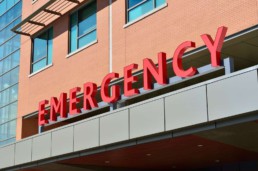How to Get the Most Out of a Doctor's Appointment
It's easy to feel hurried and confused at a doctor's appointment or unsure of the information and instructions you are given.
The medical system is complicated and may be overwhelming. But with a little preparation you can become your own health advocate. In order to get the best possible outcomes, it really helps to be active.
Here are some ways to make sure that you get the most out of a visit to the doctor.
Get Ready Ahead of the Doctor’s Appointment.
How many times have you left a doctor's appointment only to think of a question that you wish you'd asked during the appointment? This can be easily resolved by creating a list of questions ahead of the visit to the doctor’s. The questions can be about something complicated, including your treatment, or simple, like if you should get a flu shot. Write down your own questions, because it is so easy to forget everything you wanted to ask.
Describe Your Symptoms to the Doctor
Give all information regarding your symptoms and other health concerns, even when you're not asked. The doctor needs to understand why you are there and what is bothering you. Take into consideration which health problems you may have. Are you currently struggling with insomnia, or feeling depressed all of the time, or having even more heartburn than normal? The more information your doctor has, the better he or she can get to the bottom of what's going on with your body.
Ask the Doctor Questions
Remember, it is your body and you should be the person who is most motivated to know about what’s going on with your body. It is much better to be pushy than not to understand what to do to take care of yourself. Ask your doctor anything and everything, and write down the answers.
Bring a Buddy to the Doctor’s Appointment
Because doctor’s appointments may be a little confusing, it will help to have an extra pair of ears to pick up on directions and other information. It is tough to keep track of all the information from your doctor. Having someone who can take notes and help you have more info can be helpful, because it can be overwhelming to listen to information about a new diagnosis or complicated changes to your medicines.
Bring Drugs You’re Currently Taking
Bringing your current list of drugs to show your physician helps the physician understand what you're taking. Include the names of the medications, the doses, and the schedule of when you take those drugs. This includes vitamins, nutritional supplements, and over-the-counter medication. You can also simply put all of your pill bottles and other medicines in a reclosable plastic bag. That's easier for you because you don't need to write down complicated names and doses.
Get a Recap of the Appointment.
Before leaving your appointment, ask for a recap. Write things down, so you can recall what you talked about after the doctor’s appointment. And also, make sure to know how to contact your physician's office if you have further questions. How are you supposed to let them know if the treatment is--or isn't--working? How can you get in touch with somebody?
What is a dermatologist?

What is a dermatologist?
What is a dermatologist and what does a dermatologist do? You may think a dermatologist does some advanced form of skincare, but that is far from a complete view of what a dermatologist is.
A dermatologist is a doctor that specializes in the health of the skin, nails, and mucous membranes.
A dermatologist can also assist patients to revitalize the look of hair, the skin, and nails.
Dermatologists treat over 3,000 skin conditions, such as acne, psoriasis, and skin cancer.
In addition, they are trained to carry out skin grafts the excision of lesions, and much more.
What is dermatology?
Dermatology is an area of medicine concerned with diseases of the hair, nails, and mucous membranes and also the health of the skin.
The skin is the biggest organ in the body. It frequently reflects health, and is the first line of defense against harm and bacteria.
Qualifications for a Dermatologist
Some professionals in beauty practices and spas call themselves dermatologists, but they do not have the appropriate accreditation.
A professional dermatologist will be board-certified by the American Osteopathic Board of Dermatology, the American Board of Dermatology, or the Royal College of Physicians and Surgeons of Canada.
A dermatologist has to finish both college and medical school as either a medical doctor (MD) or a doctor of osteopathic medicine (DO). They will have finished a residency involving a year of work as well
Check out here for more info on qualifications for a dermatologist in Canada.

Common conditions treated by Dermatologist
Dermatologists can treat over 3,000 conditions.
The practice of dermatology requires great knowledge. Dermatologists need to know the numerous internal conditions that can lead to skin symptoms.
Here are a few examples of the common conditions dermatologists are trained to treat.
Vitiligo: The skin loses melanin, leading to patches of darker coloured skin.
Acne: One of the most common ailments, acne is a disease affecting the oil glands of the skin. A variety of causes can result in a lot of different kinds of pimples. Acne can result in low self-esteem, depression, and scarring.
Dermatitis and eczema: Dermatitis is inflammation of the skin. It typically leads to swelling and itchy rash. Dermatitis takes distinct forms, including atopic dermatitis, seborrheic dermatitis, and contact dermatitis. Each affects the skin differently.
Fungal Infections: Fungus can irritate the skin, nails, and hair. Fungal infections are common, and symptoms are typically mild. Severe symptoms can be seen in people with less immunity. A group of yeasts called Candida can result in a wide range of infections, including oral thrush and balanitis.
Hair disorders: The loss of hair may be the result of an isolated issue, or an underlying illness, such as alopecia. Hair can also be affected by head lice.
Nail problems: Dermatologists also treat conditions affecting the nails. These often consist of fungal infections and ingrowing toenails. They can be indicative of other problems.
Psoriasis: This is a chronic, autoimmune skin disorder that accelerates the growth of skin cells. This leads to thick skin and silvery scales. There are several distinct types of psoriasis. Psoriasis can sometimes have a similar appearance to eczema.
Rosacea: Rosacea causes inflammation at the face, similar to blushing. Small, pus-filled lumps often appear, and rosacea may also lead to visible blood vessels and swollen eyelids. Rosacea can spread from the nose and cheeks to the brow, chin, ears, chest, and back. Middle aged women with fair skin often experience rosacea.
Skin Cancer: Over 80,000 cases of skin cancer are diagnosed in Canada each year. Most skin cancers can be resolved by early treatment.
Shingles, or herpes zoster: This viral infection affects the nerve endings in the skin and causes a painful rash. Even though the condition clears after a couple of weeks, intervention is suggested to accelerate recovery after the disease has gone, and prevent long-term pain, numbness, and itching. Shingles can also possibly damage the eyes.
Warts: Warts are infectious, benign skin growths that appear when a virus infects the top layer of skin. Warts can indicate a problem with immunity, but they often are resolved without treatment. A dermatologist can use a variety of treatments to get rid of warts that are persistent.
Dematology Procedures
Dermatologists use a range of medical and cosmetic surgical procedures.
Some need invasive therapy or surgical intervention, although dermatological conditions could be treated with treatment. Dermatological processes can take place in a hospital setting, such as a doctor’s office, or through a hospitalization.
Biopsies: Skin biopsies are largely taken out to diagnose or rule out certain skin ailments. There are three commonly-performed kinds of skin biopsy. Shave biopsies and excision biopsies remove tiny sections of skin’s upper layer and areas of skin, respectively.
Chemical peels: A chemical solution is applied to the skin. Dermatologists use this process to take care of some types of acne and skin. It can address complaints of a decorative nature, like age spots and lines under the eyes.
Cosmetic injections: Scarring, wrinkles, and lost fullness can be diminished with injections. A dermatologist may inject botulinum toxin therapy, or fillers such as collagen and fat, through an office visit. Outcomes of this treatment tend to last for a month or two, and injections need to be repeated. Some people are able to create antibodies to Botox that make replicate treatments ineffective.
Cryotherapy: This is a fast and common form of treatment for all benign skin conditions, like warts. Skin lesions are frozen to ruin the affected skin cells.
Dermabrasion: Using a high-speed rotating brush, a dermatologist removes the top layer of skin, surgically eroding scar tissue, fine wrinkles, tattoos, and potentially precancerous skin patches.
Excisions of lesions: Skin lesions are excised for several reasons. They are removed to stop disease from spreading, for cosmetic reasons, to prevent repeat disease, to alleviate symptoms, and for identification. Based on the lesion’s size, local or general anesthetic can be used to numb the area before elimination.
Hair removal and restoration: Hair loss can be treated with hair transplantation or surgery to the scalp. Body hair may be removed with waxing that destroys hair follicles, or laser hair epilation.
Laser surgery: Dermatologists can use a special light beam to treat many different skin complaints. These include moles, warts, tumors, tattoos, birthmarks, scars, wrinkles, and hair.
Mohs surgery: This is a specific kind of surgery for skin cancer. Layers of the skin are removed and examined under a microscope to get rid of cancerous cells. Successive layers are removed until the surgeon may discover no longer cancer cells. Mohs surgery is only performed by Mohs surgeons also requires extra training.
Psoralen combined with ultraviolet A (PUVA): Psoralen is a drug that makes the skin more sensitive to radiation treatment. This is used to treat serious skin diseases, such as psoriasis, dermatitis, and vitiligo.
Skin grafts and flaps: Dermatologists can repair missing skin with skin from elsewhere on the body. Skin may be grafted with no blood supply out of a piece of tissue, or a skin flap can be created from skin tissue close to the region of skin loss.
Tumescent liposuction: Dermatologists use a procedure called liposuction to remove excess fat. Large quantities of local anesthetic are injected into the fatty tissue, which is then sucked from the body. Tumescent liposuction is not a treatment for obesity, but a cosmetic process for body contouring. Dermatologists can also use fat cells to burst and also help remove fluid that is tumescent.
Vein Therapy: Superficial leg veins are small, dilated surface veins. They are also referred to as spider veins and are frequently removed for cosmetic reasons. Sclerotherapy is usually the preferred treatment for spider veins. Dermatologists insert a solution to the vein. This irritates the lining, causing it to shut. The vein becomes less distinct or disappears entirely.
When should you see a dermatologist?
If your skin condition is not responding to home treatment, you should see a dermatologist.
People with cosmetic concerns may consult with a specialized cosmetic dermatologist.
Those seeking skin cancer examinations should also visit a dermatologist.
Go over any dermatological treatment with your insurer. Cosmetic procedures are not often funded by insurance companies. Make sure you get copies of any relevant reports, consultation notes, and test results to confirm to the insurance company that the treatment is medical necessity.
The Difference Between Cold and Flu?
It can be hard to tell the difference between a cold and the flu. This is because a cold and the flu have so much in common it may at times be tough to tell them apart. Both are brought on by viruses that infect your airways. They have some of the very same symptoms which could leave you feeling unhappy.
But it’s important to know the difference between a cold and the flu, because the flu is so much worse than a cold.
So here are the differences between the symptoms of a cold and the symptoms of the flu.
For a cold, your symptoms will be like these:
- runny or stuffy nose
- sore throat
- sneezing
- cough
- headache or body aches
- mild tiredness
For the flu, your symptoms can include:
- dry, hacking cough
- moderate to high fever, although not everyone with the flu will run a fever
- sore throat
- shaking chills
- severe muscle or body aches
- headache
- stuffy and runny nose
- severe fatigue that may last up to two weeks
- nausea and vomiting (most common in children)
Other Ways of Telling the Difference Between Cold and Flu
Other than the symptoms, here are some ways to tell whether you have the cold or the flu. You can get a cold anytime, including spring, summer, or fall, but probably in winter.
Flu season typically runs from November through March, even though you can get it in October or as late as May. You can grab the flu at other times of the year. But symptoms outside of flu season are far more likely to be from a cold or an allergy.
Also, the flu tends to be considerably worse than a cold. The flu, especially in children and older individuals, is more likely to cause serious health problems like pneumonia and a hospital stay.
Rarely, symptoms might be inadequate for your doctor to know whether it is a cold or the flu. If you’re not sure, you should do a test to learn what you have.
Private Healthcare in Canada

Private Healthcare in Canada
Private healthcare in Canada is a restricted, but growing sector within the Canadian healthcare system.
Public healthcare is one of the hallmarks of the Canadian social security system and is highly lauded. In 2017, total health expenditure in Canada was expected to reach $242 billion, or $ 6,604 per person. Overall, health spending represents around 11.5% of Canada’s gross domestic product (GDP).
However, in addition to public health care providers such as primary care doctors and hospitals, many private clinics offering specialized services also operate in Canada. Private healthcare has grown quite a bit, with the private health sector in Canada now taking nearly a third of total health expenditures, largely in the form of out-of-pocket payments and private extended health insurance. That’s because important health services like prescription drugs, mental health supports, dental care, optometry, physiotherapy and home and community care largely fall outside the scope of public coverage, much more so than in Europe.
Under federal law, private clinics are not legally allowed to provide services covered by the Canada Health Act. Regardless of this legal issue, many private clinics still do offer such services.
Private clinics’ advantage is they generally offer services with wait times that are reduced when compared with the health care system, which may have a lot of issues regarding long wait times for procedures. For instance, getting an MRI scan at a hospital could need a period of months, whereas it could be obtained much quicker in a practice.

Currently, private clinics are a subject of much controversy. There are varying views around private clinics, and there are those who argue for its contributions, and there are those who criticize them. One of the main criticisms is that their existence unbalances the health care system and favors treatments to those with higher incomes. Costs in private clinics are usually covered by private insurance policies, which will typically pay around 80% of the costs.
However, proponents say that private healthcare will make the system more efficient, benefiting Canadians. Canadians endure some of the longest wait times for medically necessary procedures. In 2015, for example, Canadians waited an average of 18.3 weeks from the moment they were referred by a GP until actually getting treatment. Canadian patients also suffer from accessibility to physicians and medical technologies.
Are you looking for a private clinic around you? Check out all clinics nearby now through the Doctr app.
Telemedicine In Canada

Telemedicine in Canada
As technology and the internet become more accessible, so too does improving access to services that would not be always available in distant rural communities, telemedicine. Studies from British Columbia and throughout the world, have shown that the benefits of telemedicine.
What is Telemedicine?
Telemedicine is the use of video conferencing and other electronics to offer access to specialized medical attention remotely, no need travel required.
What we understand as telemedicine today started in the 1950’s when university medical centres and hospital programs began to attempt to find ways to share information and images via telephone. In one of the initial successes, two health centres in Pennsylvania were able to transmit pictures.
In the first days, telemedicine was used mainly to connect doctors working to specialists with an individual at one place else. This was of excellent advantage to reach people where experts are available. So the usage of this approach, while climbing, was restricted throughout the upcoming few decades, the gear required to conduct remote visits remained expensive and complex.
The rise of the age brought with it profound changes for the practice of telemedicine. The proliferation of devices, capable of high-quality video transmission, opened up the possibility of delivering remote healthcare workplaces or assisted care centres as an alternative.

What are the Benefits of Telemedicine?
A recent study from Canada Health Infoway found that telemedicine provides value to both the individual and the provider.
The analysis found 79 percent of individuals who had a virtual visit said the quality of care was that the equal to that of an in-person visit. Furthermore, 91% of patients said they were helped by the online visit together with the health problem for which the appointment was needed by them. The study found that get access to care, individuals who elect for excursions do to save time, and prevent a work absence. Visits enabled continuity of care because of the travel burden, for those in distant communities. When telemedicine was not offered, 13 percent of patients wouldn’t have gone to medical professionals. Wait times also lessened diminishing walk-in and emergency visits.
In Ontario, the Ontario Telemedicine Network (OTN) has been researching ways to improve access to and quality of care since the late 1990’s. They’ve discovered that telemedicine has been successful in reducing patient travel, reducing hospital admissions, and improving efficiency and prompt access to care. Telemedicine adoption is accelerating in Ontario, and it is becoming an essential part of the health system. Using telemedicine has enhanced access to healthcare solutions, especially in sparsely populated areas of the province like Northern Ontario. Another study found similar advantages for obtaining pediatric mental health services in remote communities.
Other studies have examined the benefits of telemedicine for parents whose children require hospital stays. A research at Massachusetts General Hospital in Boston found telemedicine to be a viable and easy option, enabling parents to participate despite other requirements, such as work, caring for other dependants, and limited access to transportation. The research found that patients were happy with the usage of telemedicine, citing advantage and cost advantages, without compromising clinical results, as primary advantages. An Australian study echoed those findings. Telemedicine allowed children with disabilities to run visits via conference, saving the costs and time of travel, thereby avoiding the difficulties of transporting patients.
It is not just geographic and economic barriers that telemedicine can aid. For patients, Parkinson Disease telemedicine is showing benefits as well. Travel distance, developing handicap and uneven distribution of physicians can restrict access to care for many Parkinson’s Disease (PD) patients. Telemedicine can help overcome these barriers. By telemedicine, over 600 with motion disorders and over patients received care in 2012. Telemedicine can provide a patients an option that is convenient.
The Future of Telemedicine in Canada
Telemedicine is still an increasing part of the sector. It’s shown promise in gaining access to care in underserved and remote areas. Studies have shown a great number of benefits preventing work absence and convenience. Parents of children who need constant medical visits, patients with Parkinson’s Disease and individual that need access to mental health professionals in remote areas, all have found benefits. Telemedicine continues to change and improve as technologies and internet access enhances. Recognizing the potential of telemedicine will take coverage changes some time and a willingness to experiment with research versions and new care by patients, a wide range of sponsors and providers.
When to go to the Emergency Room, and when not to.

When to go to the Emergency Room, and when not to.
A high number of visits to the emergency room (ER) of a hospital aren’t considered emergencies. Many of these health issues can be addressed in a practice by a nurse or physician, a pharmacist, or care at home.
Looking for treatment at an emergency room for issues which are not emergencies poses several issues. In the emergency room, they don’t understand you and your health history, so they have incomplete details. This can lead to wasting resources and time on tests. Additionally, you’re surrounded by sick people, and that will spread infections to you; so if you’re there having a cold, the flu or other infectious illness, you can spread it to other men and women. Furthermore, it raises costs to the healthcare system. You’re taking up resources and time that could be used by those who actually do require emergency care.
When to go to the Emergency Room
There is no concrete rule on when to look for emergency medical services. But, there are a number of scenarios where the emergency area is the appropriate place to go. Listed below are common situations which may require emergency medical care. Remember, these are just general guidelines.
- Severe physical trauma, like that caused by a vehicle accident.
- Loss of consciousness (fainting) in case it happened due to an injury or causes an injury
- Severe abdominal pain: particularly with fever
- Sudden and severe headache: The worst headache of your life
- Serious bleeding that does not stop with constant stress after 10 minutes.
- Coughing up blood, blood in your vomit or bright red blood from the rectum (which isn't related to hemorrhoids).
- Sudden chest pain or the sensation of a heavy weight on your torso: This may indicate a heart attack. Other signs of a heart attack include pain at the left shoulder or arm, a burning sensation or aching beneath the breastbone (that can be confused with heartburn), light-headedness, or jaw pain.
- Acute shortness of breath
- Sudden weakness or numbness in the arms or legs and/or sudden onset of blurry vision, which could indicate a stroke.
- An extremely rapid pulse at rest with no fever that is not associated with exercise or emotional stress
- Poisoning. If you've been poisoned, first telephone Quebec Poison Control Center at 1-800-463-5060. If a person is unconscious from suspected poisoning, call 911.
If you are experiencing any one of the above conditions, immediately visit the closest emergency room or call 9-1-1 for an ambulance.
When NOT to go to the emergency room
Just as there are occasions when it’s appropriate to visit the emergency room, there are other times when it isn’t suitable to go. These include the following:
- Health issues that can be treated at home with self care measures like a cold (runny nose, congestion, watery eyes, a sore throat, and maybe sneezing), the influenza (sudden onset of a high fever, chills, muscle and joint pains and headache), a sore throat or a minor burn, cut or scrape.
- Loss of consciousness (fainting) *if no injury: The main cause of fainting is from a sudden drop in blood pressure, and the majority of the time this is not an emergency.
- Minor aches or pains
If you are having any of the above, consult with a pharmacist, or call Info-Santé (dial 8-1-1) to receive advice from a nurse.
Additionally, you shouldn’t go to the emergency room to get a prescription refilled, to get a second opinion or if your family doctor Isn’t accessible.




